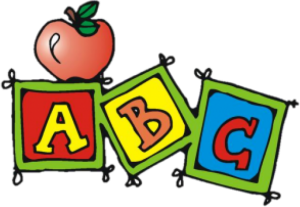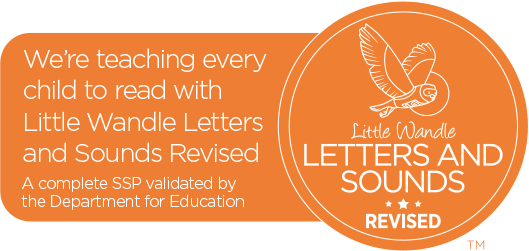OUR PHONICS AND SPELLING CURRICULUM
OUR AIMS
We teach early reading through the systematic, synthetic phonics programme Little Wandle Letters and Sounds Revised. (from September 2022.)
Phonics is the teaching of reading and writing which helps develop the learner’s phonemic awareness.
This is the ability to:
- hear, identify and manipulate phonemes (sounds)
- to understand the reading and spelling patterns that represent them.
- It helps children hear, identify and use different sounds that distinguish one word from another in the English language.
As we teach sounds in phonics, we must also teach the letter names, so that the children understand the code of letters and sounds and how they relate to each other. This must continue throughout all reading and writing opportunities. We must use ‘pure phonics’ (e.g. ‘n’ is pronounced as it would be at the start of the word ‘no’, not pronounced ‘nuh’) so that spellings are correct.
Phonics involves matching the sounds of spoken English with individual letters or groups of letters. For example, the sound k can be spelled as c, k, ck or ch. Teaching children to blend the sounds of letters together helps them decode unfamiliar or unknown words by sounding them out. For example, when a child is taught the sounds for the letters t, p, a and s, they can start to build up the words: “tap”, “taps”, “pat”, “pats” and “sat”.
The progression of phonics is planned for by the following markers however we look at the child’s stage of phonic knowledge and understanding, not just their age.
NURSERY
Phase 1
From the very beginning of Nursey, children begin Phase 1 where they are exposed to the different sounds around them and are encouraged to hear sounds and interpret and respond to them. It is necessary for a child to hear sounds around them in order for them to be able to hear the sounds in words later, and then use these sounds to help them write words.
Includes listening to and remembering:
- Environmental sounds e.g. animal sounds
- Instrumental sounds e.g. triangle, maraca;
- Body percussion – clapping;
- Rhythm and rhyme – choose the non-rhyming words from this word string; give me a rhyming word to continue this word string;
- Alliteration – find words that all start with the same sound;
- Voice sounds – make sounds for a story;
- Oral blending and segmenting.
RECEPTION
Phase 2, 3, and 4
Right from the start of Reception we begin teaching phonics from week 3. Children have a daily phonics lesson where they learn phases 2, 3 and 4. We teach phonics for 25 minutes a day, beginning with shorter 10 minute sessions and building quickly to the full length session. We teach four new phonemes and their corresponding graphemes each week, a new one each day, with the final lesson of the week being a review of the weeks learning. During these sessions children will also be taught tricky words to read.
During these phases, the children will learn to distinguish between speech sounds and many will be able to blend and segment words orally. It is very important that when we are asking children to segment and blend, we are mindful of the sounds they know, only use the sounds in the current and previous sets.
During Phase 2, pupils start to learn specific graphemes; these are taught in sets. Pupils should be able to spell some VC and CVC words and some tricky words. Sounds should be written at the point of learning them.
During the Spring term children are taught Phase 3; they will learn new phonemes by looking at the grapheme and will apply their knowledge of blending and segmenting to reading and spelling simple two-syllable words.
In Phase 4, pupils will continue practising blending for reading and segmenting for spelling. This phase is a revision of all the graphemes from Phases 2 & 3 as well as learning new tricky words.
KEY STAGE 1
Year 1 - Revise Phase 4 and Learn Phase 5
By the end of KS1, we aim for all our children to be fluent at decoding, in order to become fluent readers, and this then leads onto spelling and recognising spelling patterns within words.
Phonics lessons continue in Year 1 for 25 minutes daily. Children begin the Autumn term with 3 weeks of revising phases 2, 3 and 4 before they begin to learn phase 5. This is then taught across the whole school year. Children will broaden their knowledge of graphemes and phonemes for use in reading and spelling. They will learn new graphemes and alternative pronunciations for these and graphemes they already know. In Year 1, pupils will take part in their Phonics Screening Check.
Year 2 - Revise Phase 5 and Move Onto Spelling Rules
During this phase, children become fluent readers and increasingly accurate spellers. They will learn how to apply prefixes and suffixes as well as developing a good understanding of long and short vowels to help them with spelling rules.
As children progress through school, we continue to teach phonics to support those who have found this journey tricky or children who have joined us ‘new to country’, or those who have gaps within their phonics. We regularly assess children to identify their gaps and then use small group ‘catch ups’ or 1:1 precision teaching.
USEFUL LINKS
For further resources linked to Phonics follow these links:
- Letters and Sounds – Free Letters and Sounds Resources
- Phonics Play – Popular Phonics Resources for all ages
- BBC Bitesize Phonics – A Wide Range of Phonics Resources for both KS1 and KS2
- Family Learning – Fun Phonics Games
- Active Learn Primary
- Little Wandle – Resources for Parents
Useful Links






